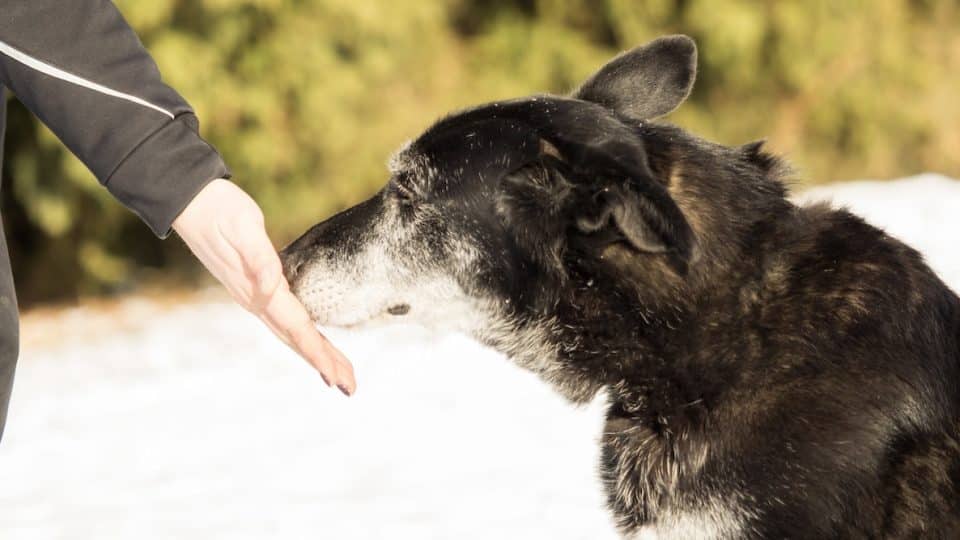There’s a lot to teach a new dog, from “sit” and “down” to “stay” and “come.” It can often feel like the most useful skills are the hardest, especially if they require a lot of foundational skills first. A “touch” cue is the exception—it’s both easy to teach and hugely impactful.
“[Touch] is so versatile that it can make a big difference in the life of any dog, whether fearful or exuberant, puppy or senior,” says certified professional dog trainer (CPDT-KA) Shoshi Parks.
“Touch” is the name many dog trainers assign to a behavior called hand targeting. Hand targeting is the simple act of a dog voluntarily touching their nose to your hand.
With Parks’s help, we’ll cover how to teach it, what you can do with it, and how to troubleshoot if you and your dog are getting stuck.
How To Teach Your Dog To “Touch”
Touch is one of the best basic cues to teach your dog—here’s how Parks says to start.
1. Set up the first touch
Start by placing your outstretched palm within a few inches of your dog’s nose. Your dog’s natural curiosity should entice them to nudge your palm. As soon as you feel the nudge, mark the action with “YES!” or a clicker and reward your dog with your other hand.
Repeat 5 times.
2. Add a verbal cue
Add the verbal cue “touch” or “say hi!” Say the cue, then immediately put out your palm. “YES!” or click when you feel your dog’s nose and reward.
Repeat 5 times.
3. Make your dog work a bit harder
Move your hand a bit farther away from your dog, so that they have to take a step towards you to touch. Say the cue, put out your hand, and mark and reward the touch.
Repeat 5 times.
4. Two in a row?
Try two touches in a row, removing your hand completely between the two cues and rewarding only at the end.
For example: “Touch” → Put hand out → Feel nose → YES! → Remove hand → “Touch” → Put hand out → Feel nose → YES! → Reward
From this point, choose your own adventure by moving farther away, raising your hand a little, or adding an additional touch.
Benefits of Teaching Hand Targeting
Hand targeting offers a huge range of benefits, from an easy way to redirect overexcited dogs to a basic form of recall. Here’s what Parks says a “touch” cue can do.
1. Give an overexcited dog an alternative behavior to jumping.
The higher you hold your hand, the more energy your dog has to burn to bounce up and touch their nose. Do several of these in a row and your dog is now playing a fun, productive game.
2. Offer a reactive dog an alternative to unwanted barking or lunging.
Starting a dog on a series of several touches in a row when you see one of your dog’s triggers coming down the street gives a reactive pup an activity that, with practice, can prevent a reaction.
3. Burn energy and make walks less boring.
Asking your dog to “touch!” several times in a row equals a happy, bouncing dog. Asking them to “touch!” with your hand above a bench or on the other side of the tree gets them engaging with their environment in more stimulating ways.
4. Provide a fearful dog with a “safe” option for saying hello to unfamiliar people.
In this case, instead of naming your hand target “touch,” you might call it “say hi!” When someone wants to greet your dog, ask them to put out the palm of their hand and tell your dog, “say hi!” This gives your dog a safe way to interact with the unfamiliar person, a better alternative to being reached for by a stranger.
Pro-tip: Touch will come in handy when boarding your dog, as it’s an easy and safe cue for recall, attention, and positive reinforcement.
5. Clarify what you want from your dog.
“Touch” can help your dog understand where you want them to stand. Good examples are when you need your dog to get into the car, get off the couch, or move out of your way in a small space.
6. Work like a mini-recall.
According to Parks, if your “magnet” is strong, saying “touch” gets your dog to come to you across a room or small outdoor space. It’s also great for teaching other skills that require targeting, like “hold.”
Troubleshooting “Touch”
Parks offers three solutions to common problem areas in touch training.
1. Your dog simply stares at your hand.
Solution: Hit the reset button by completely removing your hand. Wait a couple of seconds then put it out again. If that doesn’t work, try it again, this time taking a few steps away and returning to a different position in front of your dog.
2. Your dog doesn’t follow the cue at a longer distance.
Solution: Some dogs have trouble transitioning to longer distance touches, higher touches, or multiple touches in a row. Increase these parameters gradually. A good rule of thumb is to get five successful touches at any one location before raising the bar.
3. Your dog already associates a specific cue with an outstretched palm, like “shake.”
Solution: Modify your touch to a fist bump. Instead of stretching out your palm, make your hand into a fist and offer that to your dog. Mark and reward when they nudge your fist.
“Touch training is a game-changer for most dogs and their humans. I can’t recommend it enough,” concludes Parks.



